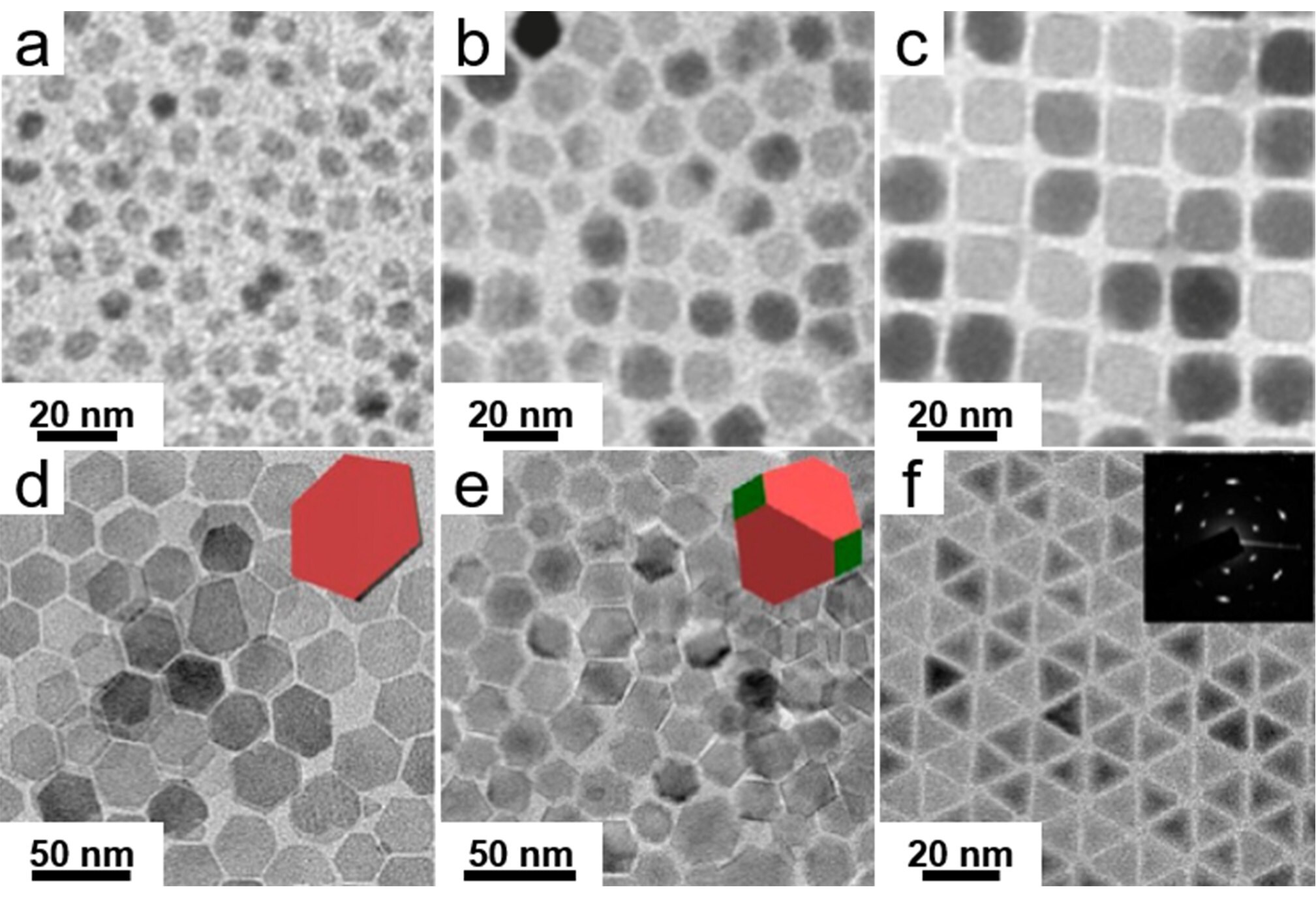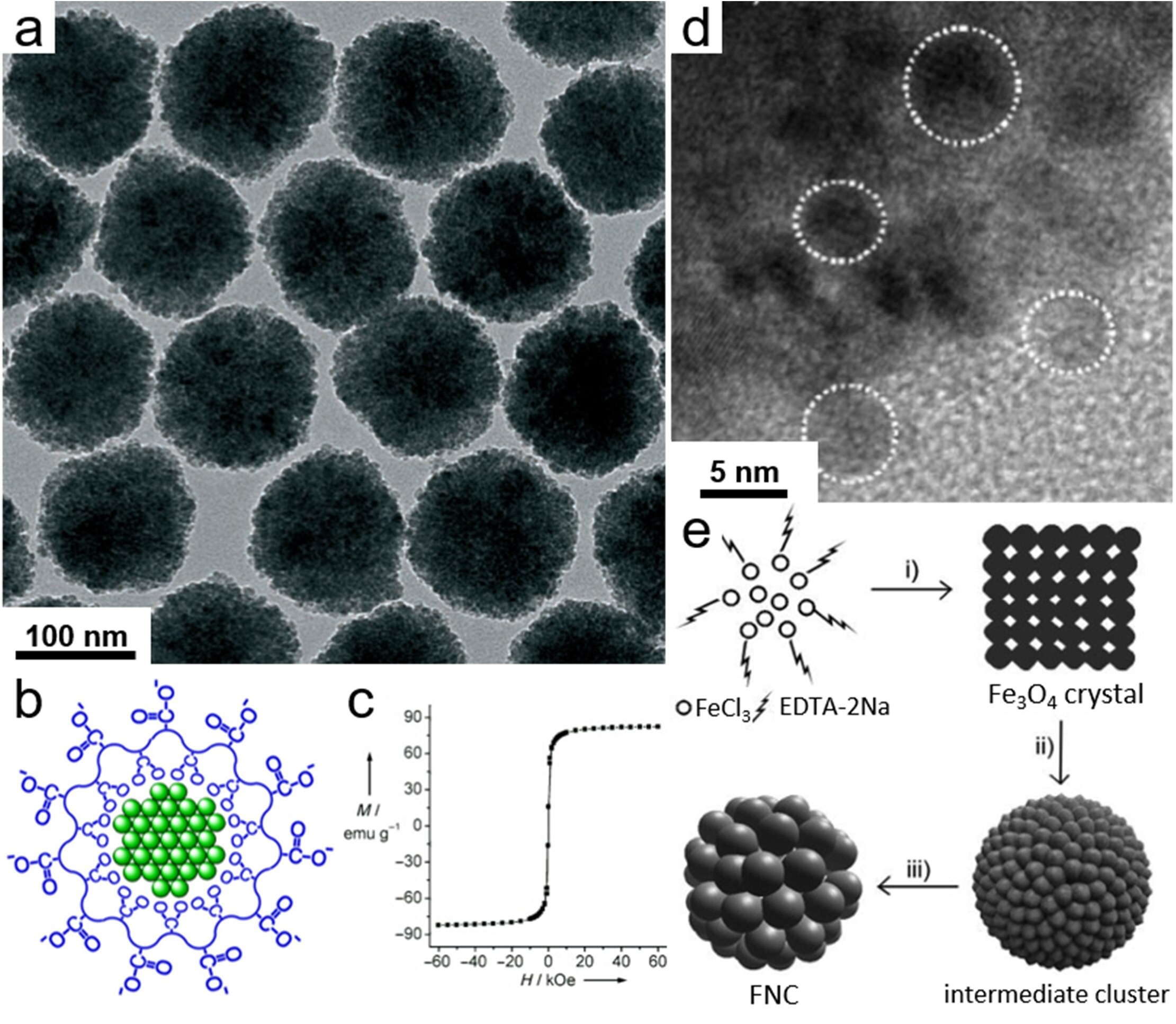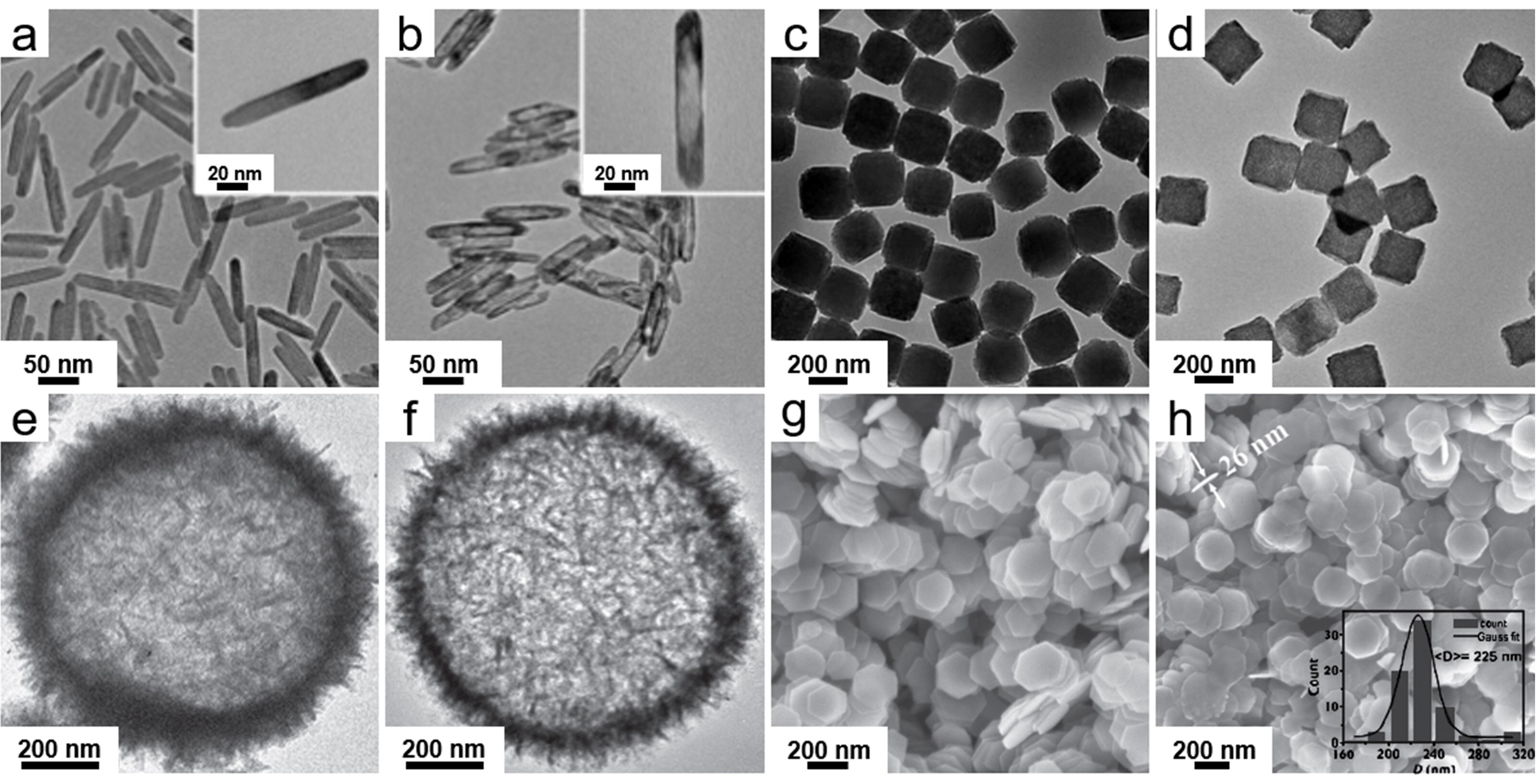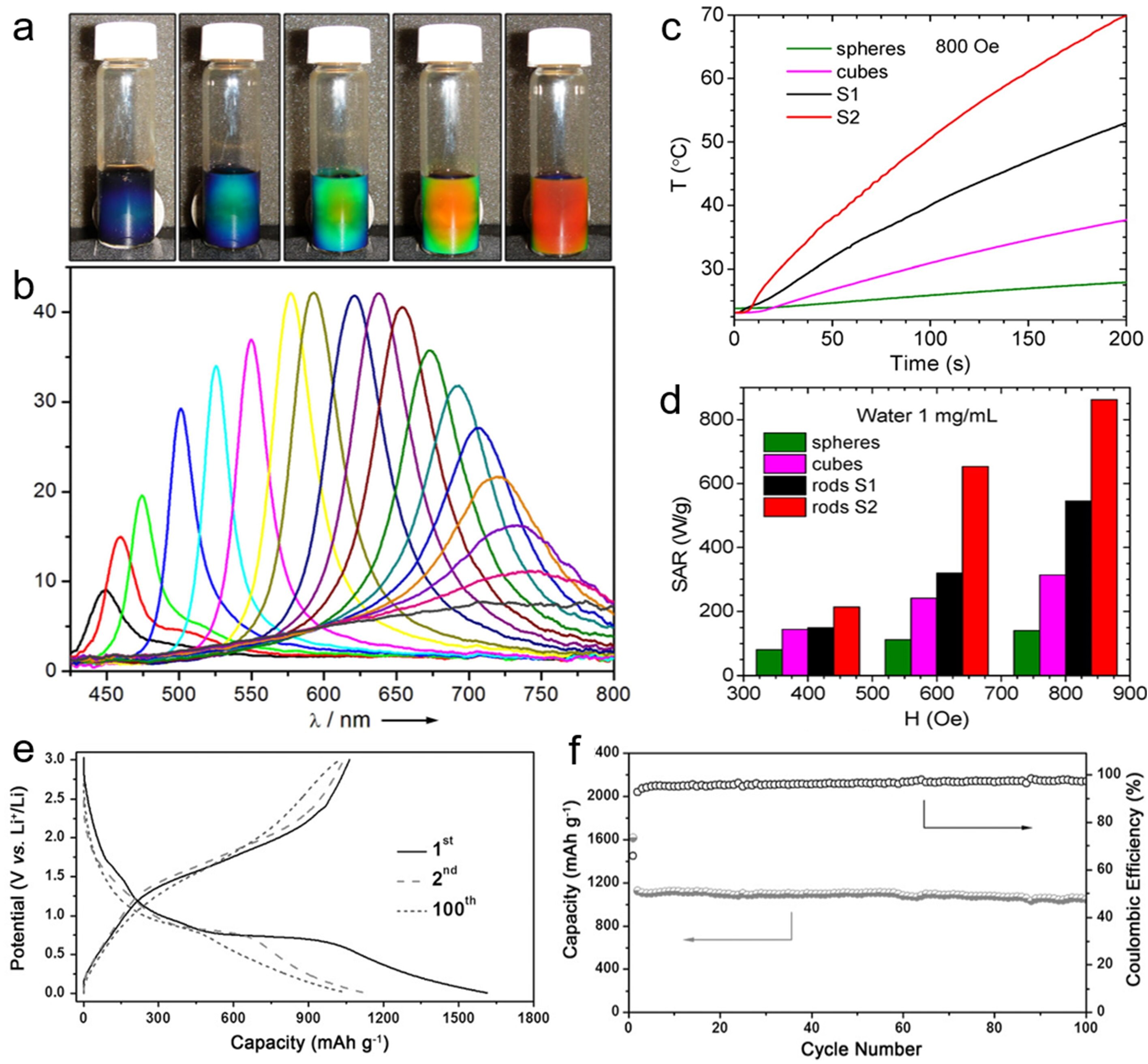Synthesis and Application of Shape-Controlled Fe3O4 Nanostructure
- Introduction
- Synthesis of Single Crystal Fe3O4 Polyhedrons
- Synthesis of Superparamagnetic Fe3O4 Nanoclusters
- Indirect Synthesis of Anisotropic Fe3O4 Nanocrystals
- Applications of Fe3O4 Nanocrystals
- Conclusion
Introduction
Magnetite (Fe3O4) nanocrystals have extensive applications in drug and gene delivery,1 field-directed assembly,2 energy storage,3 and catalysis4 due to their excellent magnetic properties, ready availability, and environmentally friendly qualities. Scientists have invested significant effort into developing reliable synthetic strategies of Fe3O4 nanocrystals, with various sizes and shapes, to obtain desirable nanocrystal properties. This review provides a discussion of both the direct and indirect synthesis of magnetite nanocrystals with wellcontrolled shapes, including nanospheres, nanocrystal clusters, nanorods and nanodiscs, as well as their application in magnetic assembly, magnetic hyperthermia treatment, and lithium-ion batteries.
Synthesis of Single Crystal Fe3O4 Polyhedrons
Since magnetite belongs to the hexoctahedral crystal class, single crystal magnetite nanoparticles tend to take an isometric morphology such as cube, octahedron, or tetrahedron. Among various synthetic approaches, thermal decomposition of iron precursors in high boiling-point organic solvents has been demonstrated to be an effective method for producing monodisperse Fe3O4 nanoparticles with high crystallinity. The synthetic mechanism is explained with the La Mer model, which typically includes three stages, nucleation, fast growth, and slow growth. The morphology of nanoparticles is determined in the slow growth stage, where the growth rate of crystals slows down due to the consumption of monomers. In this stage, facet-selective growth and Ostwald ripening process take place — both of which expose low surface energy facets and produce thermodynamically stable nanocrystals.
Since {100} facets are the most stable of Fe3O4 crystals, nanocubes enclosed by {100} facets are achieved by carefully controlling the growth rate in the slow growth stage. As illustrated in Figure 1A–C, single-crystalline Fe3O4 nanocubes can be obtained by injecting iron acetylacetonate in benzyl ether solution into hot benzyl ether (W237108) solution containing oleic acid (OA, 1008) and oleylamine (O7805) as surfactants at a steady rate.5 Figure 1A–C demonstrates the morphology evolution of Fe3O4 crystals at 10 min, 30 min, and 2 h after the reaction is triggered. The increase in crystal size occurs mainly in the first 30 min, while the particles start to take cubic shape after this period. The size of nanocubes can be tuned by changing precursor concentration and injection rate, which changes the monomer concentration at the beginning of the slow growth stage.
To obtain Fe3O4 nanocrystals enclosed by other facets, the surface energy of facets must be altered. Surfactants have been long-recognized as a significant factor for changing the surface energy order of facets by selectively binding to certain facets through coordination. It has been reported that despite having the same organic compound, oleic acid and sodium oleate (NaOL, O7501) had different facet selectivity.6 OA can universally bond to all facets of Fe3O4 crystals, leading to spherical nanoparticles. Meanwhile, sodium oleate can selectively bind to {111} facets of Fe3O4 resulting in hexagonal nanoplates, truncated octahedrons, or tetrahedrons depending on the sodium oleate to iron oleate (NaOL/FeOL) ratio added in the system. Figure 1D–F shows the morphology of Fe3O4 crystals prepared with NaOL/FeOL ratio of 1:10, 2:10, and 6:10, respectively. With increasing ratio of NaOL, the morphology of nanocrystals evolves from nanoplates to truncated octahedrons and eventually tetrahedrons, all of which are enclosed by {111} planes, evident in the high-resolution transmission electron microscopy (HRTEM) images and SAED patterns.

Figure 1.Transmission electron microcrospy (TEM) images of Fe3O4 NPs withdrawn from the reaction solution at A) 5 min, B) 30 min and C) 1 h after the injection was triggered.5 TEM images of D) Fe3O4 plates, E) truncated octahedrons and F) tetrahedrons. G) Schematic illustration of the proposed growth model for MNCs.6
A comprehensive investigation into the synthetic conditions reported by Swihart, et al. provides a thorough review of the influence of solvents, diols, and surfactants in the crystal growth.7 It was revealed that the by-product of the exposure of benzyl ether to oxygen can influence the morphology and size of Fe3O4 nanocrystals. The presence of benzaldehyde (418099), a by-product present in oxidized benzyl ether, increases the average size and promotes faceting of the nanocrystals. Due to the difference in functional groups, oleic acid and oleylamine behave contrarily in the synthesis of Fe3O4 nanocrystals. Oleic acid, with a stronger coordination bond with the Fe3+, increases the size of nanocrystals while oleylamine does the opposite. While other factors mainly influence the size of the final products, diol species are crucial to the morphology of prepared Fe3O4 nanocrystals. Diols with shorter carbon chains such as 1,2-tetradecanediol (260290), promote the exposure of {100} facets, leading to cubic nanocrystals. Meanwhile, 1,2-hexadecanediol (213748), with longer carbon chains, produce octahedral nanoparticles by slowing down the growth on {111} facets.
Synthesis of Superparamagnetic Fe3O4 Nanoclusters
It is well known that when crystal size is reduced below a critical size (around 20 nm), Fe3O4 crystals will exhibit superparamagnetism. The fast and reversible assembly behavior also makes them a promising candidate for the fabrication of magnetically responsive smart materials. Assembling the nanoparticles into a secondary structure grants the potential of harvesting collective and size-dependent properties in addition to the superparamagnetic properties of the nanoparticles.
Yin’s group reported the synthesis of poly(acrylic acid) (PAA, 323667) capped Fe3O4 colloidal nanocrystal clusters (CNCs) with tunable size by hot injection of NaOH/diethylene glycol solution (DEG, 32160) into reaction mixture containing DEG, FeCl3 (451649), and PAA.2 The TEM image (Figure 2A) shows the morphology of as-prepared CNCs, and Figure 2B shows the proposed structure of the clusters. As shown in Figure 2C, regardless of the overall size at about 180 nm, the CNCs shows superparamagnetism due to the small grain size of Fe3O4 crystals. The numerous efforts to synthesize CNCs with similar superparamagnetic properties has been previously documented. For example, as reported by Zhao’s group,8 magnetite CNCs were synthesized by a solvothermal process by reduction of FeCl3 at 200 °C with ethylene glycol (324558) in the presence of sodium acetate (NaAc, 229873) as an alkali source and trisodium citrate (S4641) as capping ligand. Carboxyl groups in sodium citrate have a high affinity towards Fe3+ and provide strong electrostatic repulsion force by increasing the surface charge of the CNCs. The size of each Fe3O4 nanocrystal was determined to be 5–10 nm by HRTEM images (Figure 2D). In another solvothermal approach reported by Fang’s group,9 it was found that the amount of NaAc determined the grain size of Fe3O4 crystals, and grain size up to 30 nm was achieved (Figure 2E). In the meantime, the overall size of the secondary structures can be tuned by changing the amount of EDTA-2Na (E4884) or the sonication treatment time before the solvothermal process.

Figure 2.A) TEM image and B) schematic illustration of poly(acrylate) capped Fe3O4 colloidal nanocrystal clusters. C) Hysteresis loop of 180-nm CNCs measured at room temperature exhibiting superparamagnetic behavior.2 D) HRTEM image of 250 nm Fe3O4.8 E) Schematic illustration of the formation and structure evolution of CNCs. i) EDTA-2Na stabilized Fe3O4 crystals are formed through the hydrolysis of FeCl3 under solvothermal condition. ii) Aggregation of Fe3O4 crystals to form loosely packed intermediate clusters. iii) Intermediate clusters go through a reorganization process to form CNCs.9
Indirect Synthesis of Anisotropic Fe3O4 Nanocrystals
Despite advances in the synthesis of Fe3O4 nanocrystals, only a few works have reported the direct synthesis of anisotropic nanocrystals such as nanorods,10 nanowires,11 and nanoplates12 due to difficulties in symmetry breaking of the magnetite’s isometric crystal structure. However, Fe-based crystals belonging to other crystal classes can grow into anisotropic nanocrystals, as a result of the low symmetry of their crystal structure. Taking advantage of the crystal structure of various Fe based crystals such as FeOOH, Fe2O3, and Fe based metalorganic framework, uniform and monodisperse anisotropic nanocrystals can be prepared then transformed into Fe3O4 by reduction or high-temperature annealing.
Yin’s group reported a universal surface protected reduction strategy where PAA was used as capping ligand during the high temperature of β-FeOOH nanorods in DEG.13 Typically, reduction of β-FeOOH in DEG requires a protective layer such as silica to prevent β-FeOOH from being dissolved due to the formation of Fe-glycolate. In this work, the rod morphology of β-FeOOH can be well maintained by simply introducing PAA into the reaction. Due to the strong bonding between Fe3+ and carboxyl groups of PAA, the outmost layer of β-FeOOH nanorods was protected by PAA, preventing the formation of Fe-glycolates. As shown in Figure 3A–B, the reduction of β-FeOOH nanorods in DEG with the presence of PAA results in hollow Fe3O4 nanorods with wellpreserved outer shells. The method also shows versatility towards other Fe based compounds including α-Fe2O3 nanospheres and Prussian blue nanocubes, as shown in Figure 3C–D.
Conversely, Ma et al. took advantage of the formation of Fe-glycerate and developed a two-step method to synthesize hollow Fe3O4 microspheres consisting of small nanoplates.3 The first step involved the self-templated formation of Fe-glycerate in a solvothermal reaction of the mixture of Fe(NO3)3 (529303), glycerol (G7893), isopropanol (733458), and a small amount of water. After investigating the particles obtained at different stages, it was found that the hollow Fe-glycerate originated from amorphous metal alkoxide between iron and isopropanol (Fe-IPA) complex spheres. Under elevated temperature, Fe-glycerate grew on the surface of Fe-IPA spheres while Fe-IPA spheres gradually disappeared. After the Fe-glycerate hollow spheres were obtained, Fe-glycerate decomposed under annealing condition in N2 (295574) atmosphere at 350 °C. The hollow sphere morphology can be well preserved without server aggregation.
Although α-Fe2O3 nanocrystals with well-defined shapes and narrow size distribution are relatively easy to obtain, the transformation from α-Fe2O3 to Fe3O4 by traditional thermal annealing in reductive gas requires high temperature, which leads to the sintering of nanoparticles. The hydrogen-wet reduction method, on the other hand, could effectively avoid the sintering problem due to moderate reaction temperature (≈340 °C) and the usage of surfactants. As reported by Yang et al.,14 monodisperse Fe2O3 nanodiscs were first synthesized through hydrothermal reaction. NaAc in this reaction serves both as alkali source and capping ligand that binds to specific facets of α-Fe2O3 crystals and facilitates the anisotropic growth of α-Fe2O3. As-prepared nanodiscs were then heated in a mixture of trioctylamine (T81000) and oleic acid fluxed under sufficient gas flow of H2 (5%) and Ar (95%) at 340 °C. As shown in Figure 3G–H, no morphology or aggregation can be observed after reduction of the nanodiscs.

Figure 3.A–D) TEM images of β-FeOOH nanorods and PB nanocubes before (A, C) and after (B, D) surface-protected conversion.13 TEM images of E) Fe-glycerate hollow spheres and F) Fe3O4 hollow spheres.3 SEM images of iron oxide nanodiscs G) before and H) after reduction. The inset in (H) is the diameter distribution of the nanodiscs after reduction.14
Applications of Fe3O4 Nanocrystals
Fe3O4 nanocrystals are widely used in magnetic resonance imaging, drug/gene delivery, and data storage because of their strong magnetic properties. However, there are several applications that do not rely solely on the magnetic properties or utilize less desired properties in a traditional sense.
Photonic crystals, typically constructed by controlled drying or supersaturation of uniform colloidal particles, show highly saturated color due to their unique photonic bandgap. As reported in Yin’s work, PAA capped Fe3O4 CNCs are ideal for the construction of magnetically responsive 1D photonic crystals.2 The superparamagnetic nature of CNCs and strongly negatively charged surfaces provided by PAA allow for fast and reversible assembly of CNCs. The photonic bandgap can be tuned through the whole visible range by changing magnetic field strength applied as shown in Figure 4A–B.
Magnetic hysteresis, a common phenomenon that occurs when an external magnetic field is applied on a ferrimagnet, is undesirable in many industrial applications as it partially dissipates the work into the environment as thermal energy. However, in the medical field, the application of this phenomenon shows promise in cancer treatment, due to the fact that magnetic nanoparticles can locally transform electromagnetic energy into heat in order to damage or kill cancer cells nearby.10,14,15
Research published by Srikanth’s group10 pointed out that the anisotropic nanoparticles like Fe3O4 nanorods exhibit superior magnetic hyperthermia to isotropic structures such as nanospheres and nanocubes. As shown in Figure 4C, nanorods with an aspect ratio of 11 (S2) have the highest heating rate among all four morphologies. The specific absorption rate (SAR) vs. field strength plot (Figure 4D) also suggests that Fe3O4 nanorods (S1 and S2) outperform spheres and cubes, especially when the magnetic field applied is strong. The paper also highlights the importance of orientation of nanorods. When the Fe3O4 nanorods are fixed in 2% agar gel (SIAL Cat. No. A5054), nanorods oriented along the direction of the magnetic field show higher SAR than randomly oriented nanorods.
Besides the magnetic properties, Fe3O4 as a transition metal oxide is a promising candidate for use as anode materials in high-performance lithium-ion batteries. Fe3O4 is one of the few transition metal oxides that exhibits high electronic conductivity. As reported by Lou’s group,3 hollow Fe3O4 microspheres consisting of thin nanoplates exhibit excellent electrochemical properties as potential anode materials for lithium-ion batteries as shown by their high specific capacity (Figure 4E), remarkable cyclability (Figure 4F), and superior rate capability. In addition to the advantages intrinsic to Fe3O4, the hollow structure and nanoplate subunits increase the contact surface between the active material and the electrolyte, which promote the electrochemical reactivity. Moreover, the 2D subunits ensure short transport length for Li+ ions and electrons, resulting in enhanced rate capability.

Figure 4:A) Photographs of colloidal crystals formed in response to an external magnetic field; the magnet-sample distance decreases gradually from right to left. B) Dependence of the reflection spectra at normal incidence of the colloidal crystals on the distance of the sample from the magnet. Diffraction peaks blue-shift (from right to left) as the distance decreases from 3.7 to 2.0 cm with a step size of 0.1 cm. The average diameter of the CNCs in this sample is 120 nm.2 C) Heating curves for the Fe3O4 spheres, cubes, and nanorods of similar volume (1 mg/mL) in water measured at alternating currect (AC) field of 800 Oe. D) SAR vs. field plot for the Fe3O4 spheres, cubes, and nanorods of roughly the same volume (~2000 nm3).10 Electrochemical lithium storage properties of as-prepared hierarchical Fe3O4 hollow spheres: E) charge-discharge voltage profiles for the first, second, and 100th cycles at a constant current density of 500 mA·g−1; F) cycling performance at a current density of 500 mA·g −1.3
Conclusion
In summary, Fe3O4 is one of the most studied magnetic materials due to its low cost, strong magnetic properties, and well-studied crystal structures. Polyol processes that enable high-temperature decomposition of Fe compounds are beneficial for the preparation of single-crystal polyhedrons of Fe3O4. The selective exposure of certain facets can be achieved with suitable surfactants. Besides polyhedrons, a unique Fe3O4 nanocrystal cluster structure can be obtained through a high-temperature hydrolysis reaction. Interestingly, Fe3O4 CNCs can maintain superparamagnetic properties despite their overall size of over 100 nm as a result of the fine crystal size of the subunits. In addition to direct synthesis of Fe3O4 nanocrystals, an indirect synthetic strategy can bring more complexity and tunability to the nanoparticle morphologies. Anisotropic structures with well-defined morphology and narrow size distribution or complex hierarchy structures can first be obtained, and subsequently transformed into Fe3O4 through polyol reduction or hydrogen-wet reduction processes. The strong magnetic response of Fe3O4 nanocrystals makes them ideal candidates for magnetic field induced assemblies, with promising applications in smart materials. Moreover, the biocompatibility of Fe3O4 and their magnetic hysteresis behavior opens doors to medical applications such as magnetic hyperthermia treatments. In addition to the magnetic properties, Fe3O4 has also shown excellent performance as an anode material for lithium-ion batteries due to its unique electronic conductivity and high theoretical capacity as a transition metal oxide.
References
如要继续阅读,请登录或创建帐户。
暂无帐户?